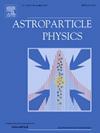Simulations of astrophysically relevant pair beam instabilities in a laboratory context
IF 2.9
3区 物理与天体物理
Q1 ASTRONOMY & ASTROPHYSICS
引用次数: 0
Abstract
The interaction of TeV blazars emitted gamma-rays with the extragalactic background photons gives rise to a relativistic beam of electron–positron () pairs propagating through the intergalactic medium, producing a cascade through up-scattering low-energy photons. Plasma instability is considered one of the underlying energy-loss processes of the beams. We employ particle-in-cell (PIC) simulations to study the plasma instabilities of relativistic pair beams propagating in a denser background plasma, using the parameters designed to replicate astrophysical jets under laboratory conditions. In an astrophysical scenario with a broad, dilute beam, electromagnetic instability is suppressed because the beam exhibits momentum anisotropy with a large longitudinal momentum spread compared to its transverse momentum. We find the range of density contrast at which electrostatic modes are dominating over electromagnetic modes with an anisotropic beam in laboratory scales, consistent with the physically relevant conditions for Blazar-induced beams. We have used a broad Cauchy distribution for the beam particles, which is more realistic in representing the non-Maxwellian nature of pair beams, improving upon previous studies. We investigate the interplay between the instability-generated magnetic field and the momentum anisotropy of the beam. We extrapolate the beam energy loss and the angular broadening due to non-linear feedback of instability. We find that the astrophysical beams have lost approximately 4% of their total energy due to instability. Nevertheless, the instability generates a negligible angular broadening for Blazar-induced beams.
实验室环境下天体物理相关对光束不稳定性的模拟
TeV blazars发射的伽马射线与河外背景光子的相互作用产生了一束相对论性的电子-正电子(e -e +)对,通过星系间介质传播,通过向上散射的低能光子产生级联。等离子体不稳定性被认为是光束潜在的能量损失过程之一。我们采用粒子池(PIC)模拟来研究在更密集的背景等离子体中传播的相对论对光束的等离子体不稳定性,使用设计的参数来复制实验室条件下的天体物理射流。在具有宽、稀光束的天体物理场景中,电磁不稳定性被抑制,因为光束表现出动量各向异性,与横向动量相比,纵向动量传播大。我们发现,在实验室尺度上,静电模式比各向异性光束的电磁模式占主导地位的密度对比范围,与blazar诱导光束的物理相关条件一致。我们对束流粒子使用了广泛的柯西分布,这在表示对束流的非麦克斯韦性质方面更为现实,改进了以前的研究。我们研究了不稳定磁场与光束动量各向异性之间的相互作用。我们推断了由于不稳定性的非线性反馈导致的光束能量损失和角展宽。我们发现,由于不稳定,天体物理光束损失了大约4%的总能量。然而,这种不稳定性对耀变体引起的光束产生的角展宽可以忽略不计。
本文章由计算机程序翻译,如有差异,请以英文原文为准。
求助全文
约1分钟内获得全文
求助全文
来源期刊

Astroparticle Physics
地学天文-天文与天体物理
CiteScore
8.00
自引率
2.90%
发文量
41
审稿时长
79 days
期刊介绍:
Astroparticle Physics publishes experimental and theoretical research papers in the interacting fields of Cosmic Ray Physics, Astronomy and Astrophysics, Cosmology and Particle Physics focusing on new developments in the following areas: High-energy cosmic-ray physics and astrophysics; Particle cosmology; Particle astrophysics; Related astrophysics: supernova, AGN, cosmic abundances, dark matter etc.; Gravitational waves; High-energy, VHE and UHE gamma-ray astronomy; High- and low-energy neutrino astronomy; Instrumentation and detector developments related to the above-mentioned fields.
 求助内容:
求助内容: 应助结果提醒方式:
应助结果提醒方式:


